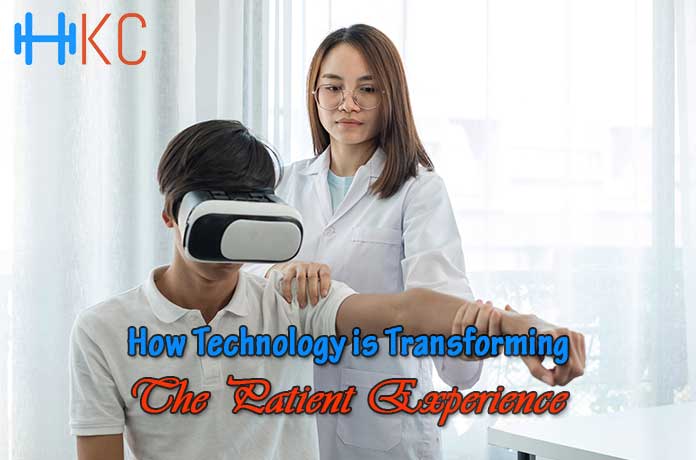
As technology advances, it profoundly impacts almost every aspect of our lives, and healthcare is no exception. There has been a rapid transformation in how healthcare providers deliver care in recent years, and technology has played a significant role in this evolution. One of the most significant changes we have seen is how technology has transformed the patient experience.
What Is Patient Experience?
The patient experience refers to the entirety of a patient’s interactions and emotions while receiving healthcare, starting with their first encounter with healthcare providers and continuing through follow-up care after treatment. It is a crucial aspect of healthcare that encompasses every aspect of the patient’s journey through the healthcare system.
The standard of care, interactions with medical professionals, availability of medical technology, the setting of the medical facility, and the emotional and social support given by medical professionals are just a few of the variables that affect the patient experience. Improving the patient experience is crucial for patients to feel appreciated, valued, and supported throughout their healthcare journey. This results in enhanced patient outcomes, elevated patient happiness, and higher-quality treatment.
Healthcare providers must learn more about the patient experience by understanding and addressing patients’ needs and concerns. Leveraging technology and other tools can enhance communication, streamline processes, and personalize care. Ultimately, healthcare providers prioritizing the patient experience are better positioned to deliver high-quality care and improve patient outcomes.
Ways Technology Transforms Patient Experience
Technology has had a transformative impact on healthcare in recent years, and one area where it has significantly improved the patient experience. Below are some ways technology transforms the patient experience and some opportunities presented by these developments.
- Telemedicine
In the past, patients had to wait in lengthy queues at the doctor’s office to schedule an appointment. Nowadays, patients can book appointments online and even have virtual consultations with their doctors through telemedicine. This modern way of delivering healthcare has made it easier and more convenient for patients.
With the help of technology, patients can now receive medical advice and treatment from their homes, benefiting individuals with chronic illnesses or mobility problems. This technological breakthrough has allowed healthcare providers to provide care from a distance and has proven to be an adequate replacement for in-person appointments for numerous patients.
- Electronic Medical Records (EMRs)
Switching from paper-based to electronic medical records (EMRs) has profoundly altered the patient experience in healthcare. Healthcare professionals now have quicker, more accurate access to patient data because of EMRs. Patient information management mistakes have decreased, efficiency has increased, and patient care has improved.
EMRs provide healthcare providers with a complete picture of a patient’s medical history, medications, and lab results, enabling them to make more accurate diagnoses and improve care coordination. Patient portals associated with EMRs also empower patients to access their medical records online, connect with their healthcare providers, and book appointments.
- Patient Portals
Patient portals have gained popularity in enhancing the healthcare experience in recent years. These portals enable patients to access their medical records online and review essential health data, including lab results, medication lists, and immunization records.
In addition, patient portals offer patients a secure and convenient means of communicating with their healthcare providers. Patients can use these portals to request prescription refills, schedule appointments, and receive test results. Adopting patient portals has resulted in higher patient engagement and improved patient outcomes.
- Wearable Technology
The patient experience in healthcare is changing thanks in large part to wearable technologies. Devices like fitness trackers and smartwatches can track a patient’s vital signs, activity level, and sleep habits, providing valuable insights into their health and helping them choose healthier lifestyle options.
Wearable technology has the potential to notify healthcare providers of potential health issues, allowing for early intervention and treatment. Patients can leverage these devices to monitor their health and make necessary lifestyle changes for improved health outcomes. Moreover, wearable technology provides healthcare providers with real-time patient data, which can guide treatment decisions and improve overall care quality.
- Virtual Reality (VR) Therapy
The use of virtual reality (VR) therapy is a cutting-edge approach that could transform the way medical treatment is administered, and chronic pain is managed. This innovative technology can provide treatment for patients with anxiety disorders, PTSD, and phobias by immersing them in virtual environments that evoke their fears.
- Personalized Medicine
Technology has also facilitated the development of tailored medicine, which fits each patient’s medical needs. A patient’s genetic makeup, medical history, and other characteristics are examined using modern algorithms and data analysis in personalized medicine to create individualized treatment recommendations.
Healthcare professionals can enhance patient outcomes and cut costs by offering patients individualized treatment regimens. Additionally, personalized medicine can increase patient satisfaction by assisting patients in feeling more in control of and involved in their healthcare.
- Artificial Intelligence (AI)
Artificial intelligence (AI) has the potential to revolutionize the patient experience in healthcare by analyzing large amounts of patient data, identifying patterns, and predicting potential health problems, helping healthcare providers intervene before they become severe.
By incorporating AI in healthcare, medical professionals can free themselves from time-consuming administrative tasks and devote more attention to providing exceptional patient care.
- Patient Education
Technology has made it simpler for medical professionals to inform people about their health and ailments. Online educational resources, instructional films, and virtual support groups are all available to patients.
Integrating technology in healthcare has empowered patients with knowledge and active involvement, resulting in improved patient outcomes. Moreover, personalized health coaching and self-care tools provided by technology enable patients to manage their health proactively.
From wearable technology and virtual reality therapy to telemedicine and electronic medical records, technology is drastically altering the patient experience in healthcare. But, healthcare professionals must always remember to ensure that all patients have equitable access to these tools and that patient privacy is maintained while they continue exploring the potential of technology.
Challenges Encountered Caused by Technology
While technology has undoubtedly transformed the patient experience in healthcare, it has also presented some challenges that healthcare providers must address. Here are some examples of the challenges encountered by technology in healthcare:
- Patient Privacy
Patient privacy and data security are under scrutiny due to the growing use of technology in healthcare. To prevent unwanted access or breaches, healthcare organizations must guarantee that patient data is securely transported and maintained.
Strong security measures are needed for this, including firewalls, data encryption, and access limits. To preserve patient privacy, healthcare professionals must also follow legislative mandates like the Health Insurance Portability and Accountability Act (HIPAA).
- Digital Divide
The digital divide refers to the unequal access to technology between different segments of society. Not all patients have equal access to healthcare technology, particularly those in underserved communities who may lack the necessary resources to access digital tools. Healthcare providers must work to bridge the digital divide by implementing programs that provide patients with access to technology.
For instance, they can develop technology centers in the community where patients can access healthcare technology, provide devices on loan to financially challenged patients, or collaborate with telecommunication firms to provide economic internet services.
- Technology Dependence
While technology can improve patient care, it can also become overly reliant on it, causing healthcare professionals to neglect crucial patient factors that technology should record.
Misdiagnosis or inappropriate treatment strategies may result from this. Using technology to improve patient care while also acknowledging its limitations is a delicate balance that healthcare providers must maintain. Through active listening, deliberate decision-making, and the use of technology, they must also put the patient experience first.
- Cost
The adoption of technology in healthcare can be a significant financial burden for smaller healthcare organizations due to the expenses associated with procuring and sustaining the technology.
Healthcare providers must weigh the benefits of implementing technology against the costs and ensure that technology is being used cost-effectively. This may include outsourcing technology services or exploring cost-sharing options with other healthcare organizations.
- Training
The proper and efficient use of technology by healthcare professionals must be taught. Healthcare providers may find it difficult to stay current on the most recent technologies and practices due to the growing complexity of healthcare technology.
It’s necessary for healthcare organizations to provide training and education to equip healthcare providers with the skills to utilize technology proficiently. This requires continuous training on new technological advancements and emphasizes the significance of retaining clinical knowledge and decision-making capabilities that cannot be entirely replaced by technology.
These are only a few instances of the difficulties that technology faces in the healthcare industry. To guarantee that technology is used safely, effectively, and fairly as well as to improve patient care and results, healthcare professionals must address these issues.
Why Is Patient Experience Essential?
Patient experience is essential in healthcare for several reasons, including:
- Improved Patient Outcomes
Patients with positive experiences with their healthcare providers tend to have better health outcomes, as they are more likely to comply with treatment plans. This is because patients who feel at ease with their healthcare providers are more inclined to openly share their symptoms, concerns, and lifestyle choices that could affect their health.
Healthcare professionals are better able to deliver individualized care that tackles the underlying causes of their patient’s health concerns when they take the time to listen to their patients and comprehend their specific requirements. Additionally, patients are more likely to adhere to their treatment plans when they feel respected and heard by their healthcare providers, which improves health outcomes.
- Increased Patient Satisfaction
Patient satisfaction is crucial to healthcare quality and is strongly linked to patient experience. Patients with a positive experience with their healthcare providers are likelier to report high satisfaction with their care.
This can lead to increased loyalty to a healthcare provider or organization and may also lead to positive word-of-mouth referrals. Patients who feel that their healthcare providers care about them as individuals and are committed to their well-being are more likely to feel satisfied with their care, even if they do not achieve the desired health outcomes.
- Financial Benefits for Healthcare Providers
Healthcare providers prioritizing patient experience are more likely to attract and retain patients, which can have significant financial benefits. Patients with a positive experience with their healthcare providers are more likely to return for future visits and may also refer friends and family members.
Additionally, healthcare organizations with high levels of patient satisfaction are more likely to receive positive ratings and reviews, which can increase their reputation and attract even more patients. This can lead to increased revenue and financial stability for healthcare providers.
- Improved Quality of Care
Prioritizing patient experience can lead to improved quality of care, as healthcare providers who take the time to listen to their patients and understand their needs are better equipped to provide personalized, high-quality care. Patients who feel that their healthcare providers are invested in their well-being are more likely to comply with treatment plans, leading to better health outcomes.
Furthermore, healthcare providers who prioritize patient experience are more likely to implement patient-centered care models, prioritizing the patient’s goals and values in treatment decisions. This can lead to better health outcomes and increased patient satisfaction.
- Increased Staff Engagement
Healthcare providers prioritizing patient experience are likelier to have engaged and satisfied staff. When healthcare providers feel they positively impact their patients, they are more likely to feel fulfilled and motivated to provide high-quality care. Also, it is more likely to have a positive work culture that values communication, empathy, and teamwork. This can increase staff satisfaction and engagement, positively impacting patient outcomes and satisfaction.
Conclusion
Technology has the power to revolutionize the patient experience in healthcare, and it is already making significant strides in improving patient outcomes, satisfaction, and quality of care. However, it is essential to remember that technology is only a tool and cannot replace the importance of human connection and empathy in healthcare.
Healthcare providers must balance utilizing technology to enhance the patient experience while prioritizing the patient’s unique needs and values. By doing so, we can create a healthcare system that is efficient and effective but also compassionate and patient-centered.









































